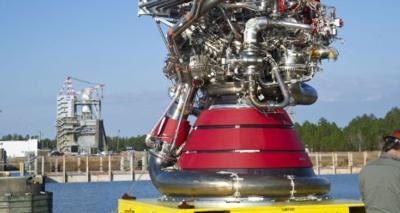Fri, Feb 15, 2013
Engine To Provide Thrust For The Heavy-Lift SLS
NASA's progress toward a return to deep space missions continues with a new round of upcoming tests on the next-generation J-2X rocket engine, which will help power the agency's Space Launch System (SLS). Beginning this month, engineers will conduct a series of tests on the second J-2X development engine, designated number 10002, on the A-2 Test Stand at NASA's Stennis Space Center in Mississippi. Once the series is completed, the engine will be transferred to the A-1 Test Stand to undergo a series of gimbal, or pivot, tests for the first time.

"The upcoming test series is not only a critical step forward, but important to the Stennis test team, as well," said Gary Benton, manager of the J-2X test project at Stennis. "This test series will help us increase our knowledge of the J-2X and its performance capabilities. In addition, the series will help us maintain the high skill level of our team as we look ahead to continued J-2X testing and testing of the RS-25 engines that will be used to power the SLS first-stage."
The first objective of the testing is to verify and demonstrate the engine's capability. Data from what is known as hot-fire engine tests will be compared to the performance of the first engine. Engineers also will vary liquid hydrogen and liquid oxygen inlet pressures and subject the engine nozzle to higher temperatures than in previous tests to see what effect they have on performance.
NASA already has conducted successful tests on engine number 10001 and on the J-2X powerpack assembly. In total, 34 tests were conducted on the J-2X engine and powerpack, with the J-2X achieving a full flight-duration firing of 500 seconds in the eighth test, earlier than any rocket engine in U.S. history. The engine is being designed and built by NASA and Pratt & Whitney Rocketdyne to power the upper stage of the 143-ton version of the SLS rocket.
The SLS will launch NASA's Orion spacecraft and other payloads from the agency's Kennedy Space Center in Florida.
(Image provided by NASA)
More News
Airport Marking Aids Markings used on runway and taxiway surfaces to identify a specific runway, a runway threshold, a centerline, a hold line, etc. A runway should be marked in ac>[...]
"It is extremely difficult, if not impossible, for manned aircraft to see a drone while conducting crop-enhancing and other aerial applications at low altitudes and high speeds. We>[...]
Aero Linx: The Skyhawk Association The Skyhawk Association is a non-profit organization founded by former Skyhawk Pilots which is open to anyone with an affinity for the A-4 Skyhaw>[...]
“The T-54A benefits from an active Beechcraft King Air assembly line in Wichita, Kansas, where all required METS avionics and interior modifications are installed on the line>[...]
Aero Linx: Aerostar Owners Association The Association offers the Aerostar Owner a unique opportunity to tap an invaluable source of information concerning the care and feeding of >[...]
 ANN's Daily Aero-Term (04.28.24): Airport Marking Aids
ANN's Daily Aero-Term (04.28.24): Airport Marking Aids Aero-News: Quote of the Day (04.28.24)
Aero-News: Quote of the Day (04.28.24) ANN's Daily Aero-Linx (04.28.24)
ANN's Daily Aero-Linx (04.28.24) Aero-News: Quote of the Day (04.29.24)
Aero-News: Quote of the Day (04.29.24) ANN's Daily Aero-Linx (04.29.24)
ANN's Daily Aero-Linx (04.29.24)



